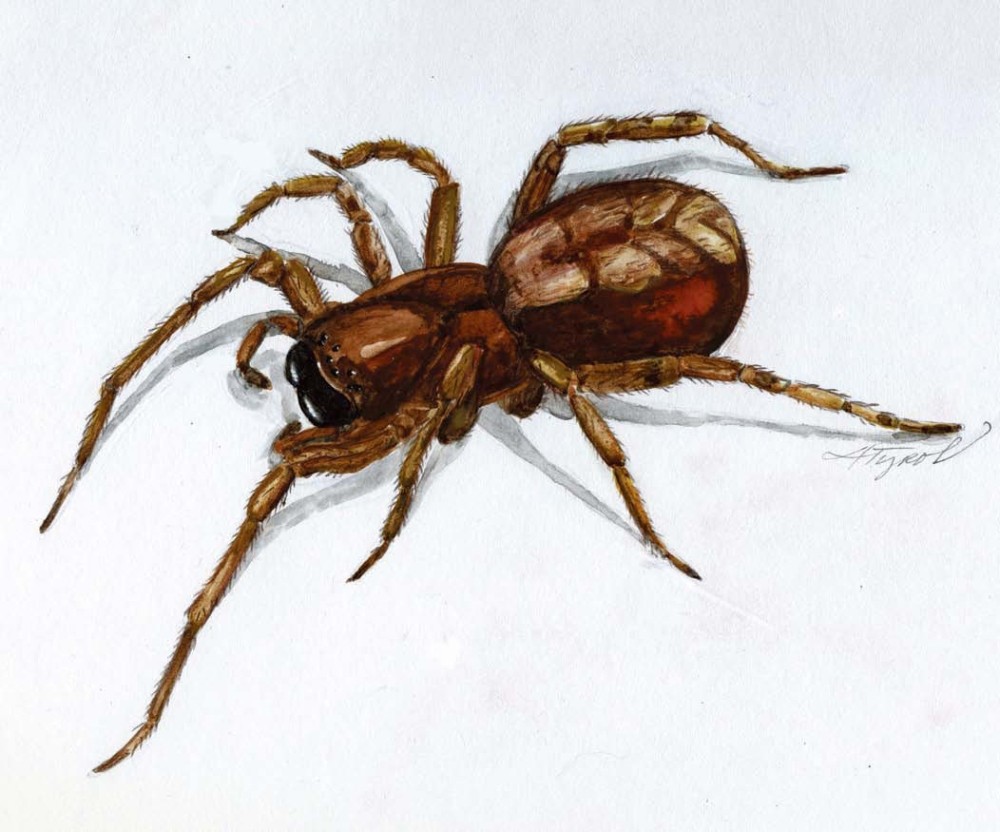Silk-spinning spiders have been around for roughly 400 million years, and they’ve made good use of their time. Today, they occupy just about every habitable region of the Earth. Scientists have identified about 40,000 arachnid species, and some think there might be four times as many waiting to be discovered. Recently, in Milbridge, Maine, two researchers collected 302 species of spiders in just one town.
Present-day spiders vary enormously in appearance and behavior, but almost all of them are predators. Males and immatures may sample plants from time to time, but it was not until 2008 that arachnologists found the first predominantly vegetarian species. Spiders are not picky about their prey, and most consume a variety of insects and other arthropods. They bite their prey with fang-tipped chelicerae and inject a paralyzing poison. Then they vomit digestive juices on the immobilized victim and slurp up the partially broken down food. This is repeated until only the indigestible exoskeleton remains.
Besides their gory eating habits, spiders are, of course, famous for their silk, and for good reason. Some spiders have eight different kinds of silk glands, each used to make a different product: drag lines, threads for the frame of the web and for the radii, sticky catching threads, material for wrapping eggs, for wrapping sperm, or for wrapping prey, and the strands of gossamer on which young spiders float through the air. The diameter of a silken thread can be adjusted at the spigot, giving yet more versatility.
Although the spider webs across the back porch and the dew-laden ones in the early morning garden are the most conspicuous, most spiders do not make orb webs. Forest-dwelling spiders create less obvious but equally effective prey-catching structures. And wolf spiders, common hunters in the forest with huge eyes, egg sacs attached to their spinnerets, and spiderlings on their abdomens, make no webs at all.
It’s easy to overlook forest spiders because they tend to be small, and they hide, are the color of leaf litter, and often lie motionless – waiting for prey to come to them. But there are lots of them. Spiders studied in a deciduous forest in Tennessee were responsible for 43.8 percent of the deaths of their fellow arthropods. Another study showed that when spiders were eliminated from a section of a forest, the population of springtails rose dramatically, and the springtails then proceeded to chow down significantly more of the precious litter layer.
Spider mating is, to put it politely, unusual. The male ejaculates into two silken pads, and then he puts these packets in the hollow ends of his pedipalps (a pair of leglike structures in front of the four pairs of walking legs). When he finds an interested female, he transfers the semen packets into her epigynum, an opening on the lower side of her abdomen. Yes, females do eat males, but in nature this is rare except in a couple of species.
Newly hatched spiders feed on the yolk of their eggs for a while, but the possibility of being eaten by their brothers and sisters provides a compelling incentive for dispersal, which spiders are good at. The tiny creatures exude strands of gossamer until it gives them just enough buoyancy to be carried away on the wind. In 1832, Darwin noted spiders landing on the Beagle’s sails when the ship was over 60 miles from the coast of South America. Much longer voyages have since been documented.
Wolf spiders are admired for their hunting prowess and parental care, but another, often overlooked forest dweller is the lovely hacklemesh weaver, a golden brown spider that creates a small, loose, sheet web. That family of spiders is sometimes called tangled nest spiders. The female has a legspan of just under ¾ of an inch; the male, as is usual among spiders, is smaller. Hacklemesh weavers are found on fallen logs, beneath peeling bark, under rocks, in rock crevices, and in leaflitter. One identifying feature of Callobius bennetti and its fellow family members is that the front part, the cephalothorax, is about the same size as the abdomen. In most spiders, the abdomen is much larger.
The hacklemesh weaver makes a special kind of silk. Instead of sticky strands, the silk is made of fine, woolly fibers that can entangle even the smallest prey. Spider wasps, a predator of many spiders, can’t contend with the hacklemesh’s web, and those that attack soon become dinner. Birds and parasites do prey on hacklemesh spiders, but their more common fate is to be eaten by another spider. Spiders are a bloodthirsty lot.



Discussion *